Archive for the 'Vegetables' Category
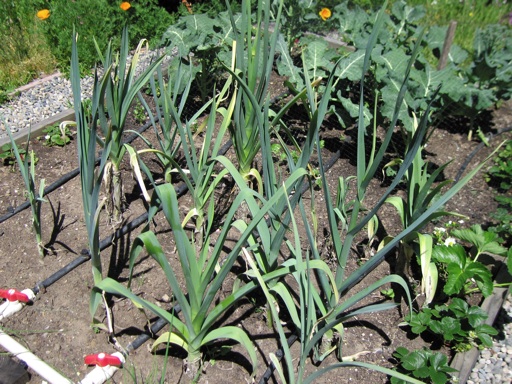
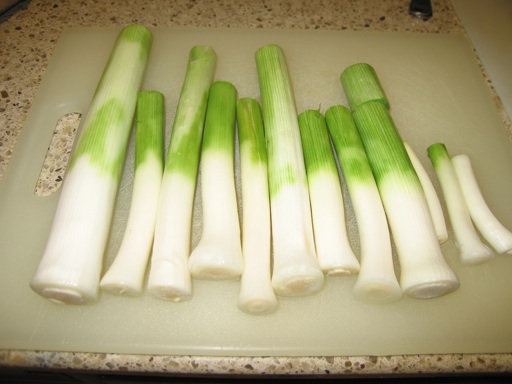
Last spring, I planted leek seeds for the first time in one of our raised vegetable garden beds. Most of the seeds sprouted within a month. Late last summer, I dug them up and transplanted them to a different raised bed where there was more room for them to grow. They didn’t show any sign of shock after the transplant, as far as I can remember. In any event, they continued to grow through fall, winter, and early spring this year.
Within the past few weeks, they started to “go to seed” (first picture above taken yesterday). That is, they started to grow long stalks with flower buds at the tip, indicating it was harvest time. Yesterday, I pulled them up, and then cut off their roots and leaves (second picture above). They weren’t any where near as large as the leeks I see in grocery stores, but I guess size doesn’t matter if you are just going to slice them. Today, I made potato leek soup for the first time with my home grown leeks. The soup turned out really well. Here is the recipe:
1 Lb. leeks cleaned and sliced
3 potatoes skinned and diced
2.5 TBS butter
3.25 cups chicken broth (may be low sodium)
1/4 cup dry vermouth
1/4 tsp white pepper
1 cup half and half
salt to taste
Saute leeks in butter and a pinch of salt for about 20 minutes until soft. Add potatoes, pepper, vermouth, and broth, bring to boil, and reduce to simmer for 30 minutes. Puree with 1/2 and 1/2. Salt and pepper to taste.
April 22 2012 | Leeks | Comments Off on Leeks
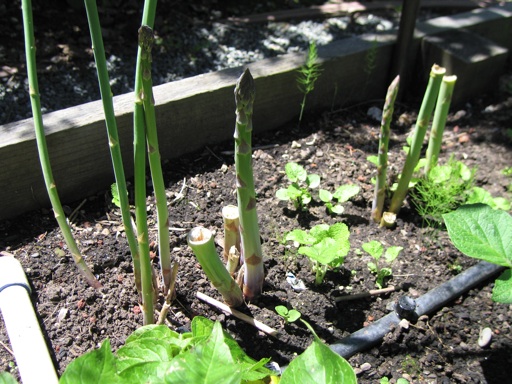
This spring, I harvested our first asparagus spears. I first planted 5 bare root Mary Washington asparagus near the edge of one of our raised beds 3 years ago. I planted them about 12 inches apart, but they are not near other plants that would crowd or shade them.
I let the asparagus grow without harvesting the spears for the first two seasons, as many publications on asparagus recommend. This year is the first year they have produced more than a few spears that are worthy of eating. I have cut about 15-20 spears in the past month. The spears first starting appearing in our garden in early March. I have let a few spears on each plant grow into ferns so that each plant is able to produce at least some sugar for the roots. I will probably continue to harvest some of the spears for a few more weeks before letting them all grow into ferns.
Once asparagus spears grow into ferns, they can become an annoyance as they often fall over into other plants or in a garden pathway. When they fall over, I usually trim the ferns back to keep them out of the way.
I have never fertilized our asparagus. Because they are growing in a raised bed filled in with compost, I don’t think they need fertilizer, especially because asparagus are long-lived perennials that have many years to grow into maturity. Although, I do water them every few days during our spring-to-fall dry season.
April 20 2012 | Asparagus | Comments Off on First Asparagus
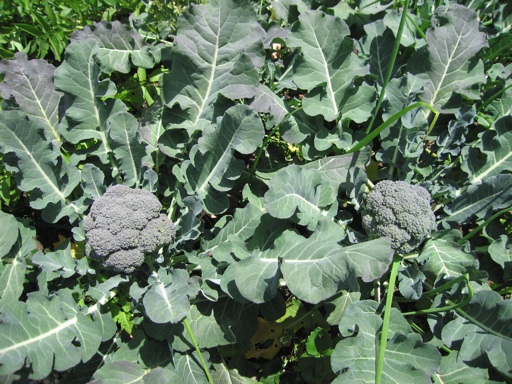
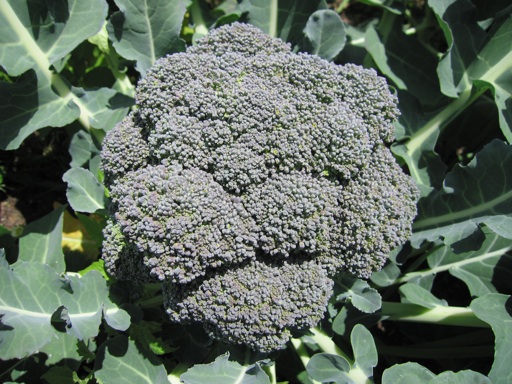
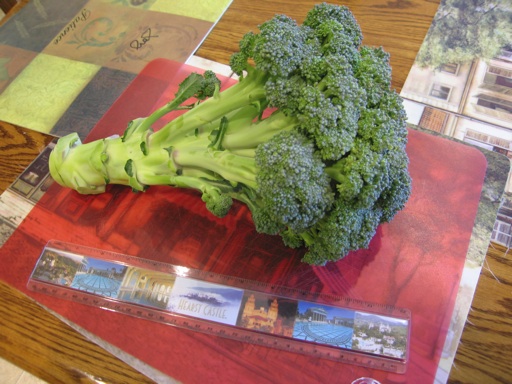
I first started growing broccoli about 2 years ago. We eat broccoli almost every week, because it’s so densely packed with nutrients. So I figured it would be fun to try to grow it ourselves. But I didn’t have much luck growing broccoli until this spring. In previous years, the broccoli plants didn’t grow much, and the broccoli heads were very small, about 3 inches wide. This year, our broccoli plants including the broccoli heads are huge. The largest broccoli head I have harvested so far this season is about 8 inches wide (see third picture above).
I planted a half-dozen broccoli seedlings back in mid-March in one of our raised beds. Last year, slugs ate many of the leaves of our newly planted broccoli seedings, which no doubt stunted their growth. So this year, I placed iron pellet snail/slug bait around the plants as soon as I put them in the ground and reapplied it every 2-3 weeks.
I fertilized our broccoli plants this year at least once a week with a water soluble general purpose fertilizer. For a period of time in April and May, I was fertilizing the plants 2-3 times a week (which may have been an overkill). Starting in early May, the plants really started to grow rapidly, and before I knew it, they were huge. Each plant is about 24 inches wide, measuring from leaf tip to leaf tip. Some of our individual broccoli heads from one plant are as big as a cluster of two or three grocery store-sized broccoli heads! In terms of flavor, our broccoli tastes about the same as grocery store broccoli. Although, our broccoli tastes fresher.
The weather in our area was ideal for growing broccoli this spring. The temperatures here have been mainly cooler than average for the past several months. Broccoli grows best with highs between about 63 and 74 degrees F. We have had very few warm days this spring, and the high temperatures have been mostly within that range. Our average high for June is about 77 degree F. Typically, it would be too warm for ideal broccoli growth by about late May in our area.
June 11 2011 | Broccoli | Comments Off on First Success with Broccoli
In March, we added two more raised beds in our backyard. We now have four raised beds that we are growing vegetables in. This year, we are growing tomatoes, potatoes, pole beans, peppers, eggplants, onions, basil, strawberries, cilantro, corn, zucchini, carrots, and cucumbers in our four raised beds. Although we haven’t harvested any vegetables yet, some of our vegetable plants are growing better than others.
Last October, I harvested seeds from dried up bean pods on our pole bean plants. I stored those seeds in a plastic bag over the winter and then planted the seeds in mid-March. Below is a picture of our pole beans today. In nearly 3 months, they have completely covered the fence I built for them last year.
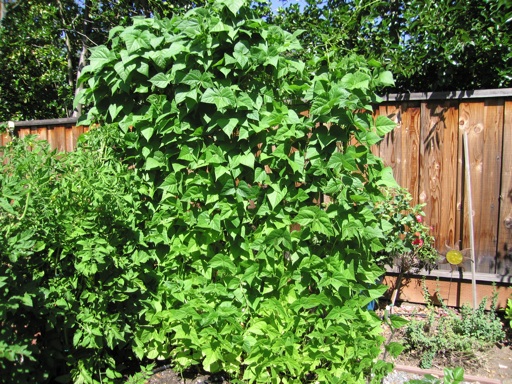
In my experience, pole beans have been really easy to grow by seed and very prolific producers. Nearly all of the seeds sprout without any stratification. And once the beans sprout, they grow quickly with minimal care and little or no fertilizer (at least in our soil which is amended with compost). Although snails and slugs will eat them if they are not protected somehow. Every year that we have grown pole beans (for about the past 4 years), they have produced more beans than we could eat.
Another plant we have had a lot of luck growing is tomatoes. We planted three tomato transplants (early girl, big beef, and champion) in March that we bought from a local nursery. They were about 4 inches tall at the time. They have grown very quickly over the past 3 months, even though the weather here has been much wetter and cooler than average. As shown in the next picture, they have already grown to completely fill their cages.
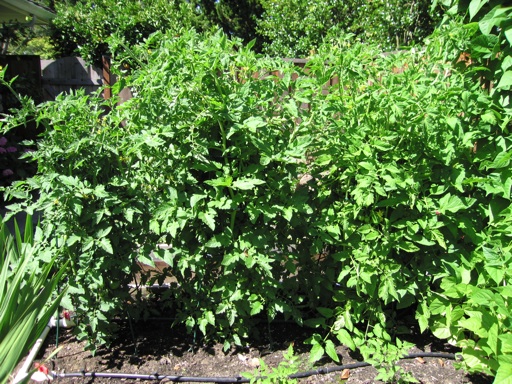
We also planted San Marzano tomatoes by seed indoors a few months ago. Growing tomatoes by seed is a first for us. Nearly, all of the tomato seeds sprouted, but as soon as I transplanted the first batch of seedlings outside in early May, they died. The remaining batches of tomato seedlings I “hardened off” by gradually exposing them to direct sunlight and the outside temperature a few hours a day. After hardening off for about 2 weeks, I planted the remainder of the seedlings outside in our new raised beds. The tomato seedlings I hardened off survived and are looking better, although they are only about 6 inches high now.
Of course, one of the advantages of growing plants by seed is access to a larger number of varieties, many of which are not easy to find as transplants. San Marzano tomatoes are supposed to be great sauce tomatoes. The next pictures shows the two new raised beds we just added in our yard. The San Marzano tomatoes are growing on the left side of the bed in the foreground.
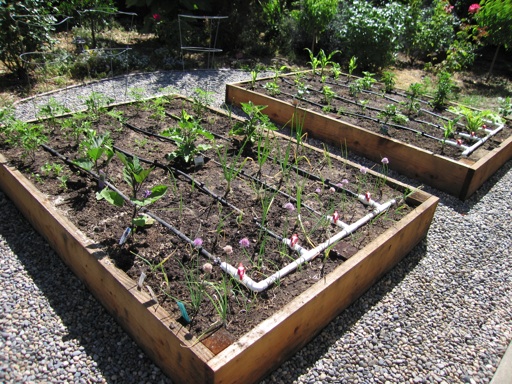
Some of the plants that we haven’t had much luck with this year are onions and leeks. I planted white onion sets, shallot sets, and leek transplants in one of our raised beds in March. The onions and leeks are growing on the right side of the bed in the foreground in the above picture. Although the onions and shallots sprouted, they haven’t grown much, and many of their leaves are turning yellow. The leeks haven’t grown at all since I planted them. I don’t have any idea why they haven’t grown well. But I tend to think that part of the fun of growing is taking a chance on growing new plants and that often means some of those plants don’t end up growing well.
Potatoes are another new plant we added to our garden this year. I planted yukon gold potatoes, which I ordered online as potato sets. I also planted white potato sets, which I purchased from a local nursery. The yukon gold potatoes look wonderful. They have already grown to about two feet tall and have really filled in the space around them (see picture below). The white potatoes sprouted, but they didn’t grow nearly as much as the yukon gold potatoes, so I ended up removing most of the white potatoes to make room for other plants.
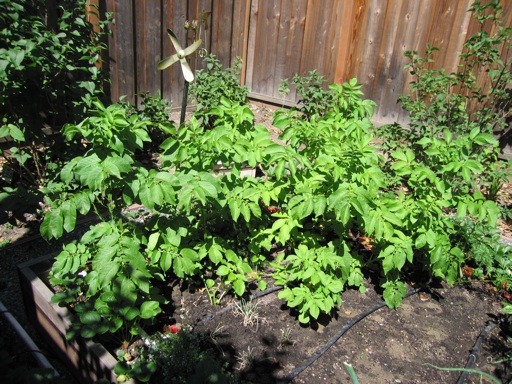
June 13 2010 | Beans and Onions and Potatoes and Tomatoes | Comments Off on Vegetable Garden Successes and Misses
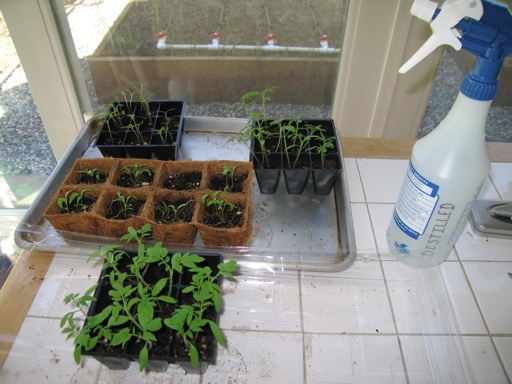
Last month, we planted several types of annual vegetables by seed indoors in containers. We planted corn, eggplant, tomato, habanero pepper, cantaloupe, and cucumber seeds. We have been watering the indoor seedlings by spraying them with distilled water in a spray bottle. Seedlings don’t need much water, and the spray bottle avoids overwatering and having to drain out excess water.
Most of the seeds we planted sprouted and grew well while they were indoors. However, as soon as we planted them outside in our raised beds, they started to have problems. Most of the tomato, cucumber, cantaloupe, and pepper seedlings that we transplanted outside a few weeks ago have died already, and the leaves of the corn seedlings are turning yellow.
I think that the problem lies with the seedlings not adjusting well to the sudden change in climate conditions from indoors to outdoors. The last few weeks our weather has been very changeable from warm sunny dry days and cool nights to cool rainy days like today, which is a big change from our stable indoor conditions. Several of the seedlings I transplanted outside during a dry sunny spell soon started to turn white as if they were getting sun burned, even though I was watering them every other day. Our low temperatures have not been dipping below about 45 degrees F, so I don’t think it was exposure to cold, although that could have been a factor as well.
I decided to do some research online, and I came across this website on hardening off transplanted seedlings from Washington State University. This website has some good pointers about gradually exposing your seedlings to strong direct sun and cold temperatures for a few hours a day. We still have some tomato and eggplant seedlings that I have not transplanted outside yet (see picture above). I intend to try gradually exposing our remaining seedlings to the sun and colder nights.
This website has some good suggestions, but I don’t agree with all of the advice on this site. One of the issues I have with the site’s advice is the minimum recommended temperatures for tomato, cucumber, and muskmelon (i.e., cantaloupe), which are 65, 60, and 60 degrees, respectively. In March, I planted 3 tomato transplants I bought from a nursery in one of our outdoor raised beds, and they are all growing rapidly even though the low temperatures here have consistently been below 50 degrees. In fact, we rarely have low temperatures above 60 degrees even in the summertime, and yet our tomato plants have thrived here in past years.
I had some left over cucumber and cantaloupe seeds. So last week, I planted them directly in our outdoor raised beds where the seedling transplants from indoors had just died. Those seeds have already sprouted despite the relatively cool temperatures. Most of these seedlings look great. None of them are looking sunburned or yellow even after a few warm sunny days last weekend. However, some of these new cucumber seedlings look like they have been picked at by birds or possibly eaten by snails, so I covered the bed with two layers of bird netting. I used this technique last year after the birds ate my first set of outdoor cantaloupe seedlings, and it worked to protect the second set of seedlings.
April 28 2010 | Vegetables | Comments Off on Growing Vegetables by Seed
« Prev - Next »










